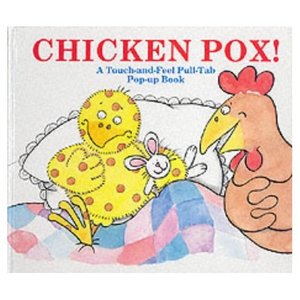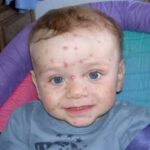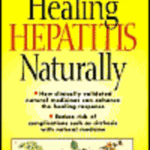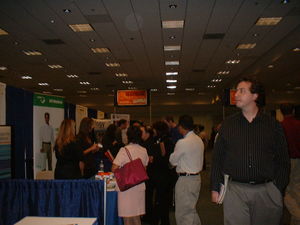In 1995, chickenpox suddenly became a major health problem. Six childrenwere reported to have died from chickenpox; frequent and repeated TVcoverage lasted for weeks without anyone mentioning that two of the sixchildren had leukemia and the others were on cortico-steroids. – Dr. F. Edward Yazbak
For most of us adults, chickenpox was a right of passage growing up. Those little itchy, highly contagious spots lasted about two to three weeks and probably left one or two scars behind. The disease was mild and we got a some ice cream and new coloring books out of it. Less than one percent of us experienced serious complications from it. Almost all of us developed lifelong immunity, and will never have chickenpox again.
Introducing the Varicella Vaccine
There is now a vaccine for the varicella zoster virus, which causes chickenpox. The Centers for Disease Control happily claim that “Chickenpox vaccine is the best way to prevent chickenpox, therefore protecting children and adults from the severe complications and death associated with the disease. Even with uncomplicated chickenpox cases, lost time from school and work and the cost of medications or treatment that may be needed can result in a significant cost for the family.
The CDC also points out that in a study (the reference is not provided), 3 out of 4 parents are unaware that chickenpox can result in death. In 1992, a typical year for chicken pox, 3.7 million cases of chicken pox were reported, and 100 deaths. More than half of those deaths were adults. Therefore, a child’s chance of dying from chickenpox was (and still is) less than 50/1,000,000 or .00005%.
The Varicella Vaccine Package Insert
Despite various organizations and health professionals supporting a mass vaccination campaign, many parents still have a difficult time deciding whether or not using this vaccine is right for their children’s health. One place a concerned parent can begin is with the vaccine’s own package insert provided by the manufacturers themselves. A vaccine’s package insert provides detailed information, including ingredients, intended purpose, efficacy, contraindications (circumstances under which a vaccine should never be administered), adverse reactions (side effects), and dosages.
Varivax is the brand name of the varicella vaccine manufactured by Merck. The package insert can be viewed in its entirety by clicking here.
Ingredients
The strain used to make the vaccine was taken live from a child with naturally occurring chickenpox, initially cultured in aborted human embryo lung cells, then unborn guinea pig embryo cells, and then human diploid (aborted embryo) cells again.
The vaccine contains gelatin, a known allergen. Children sensitive to gelatin should not have the varicella vaccine.
It also contains neomycin, an antibiotic. Children who are sensitive to neomycin should not have the varicella vaccine.
Efficacy
The CDC places the varicella vaccine at 85% effective – in other words, out of every 100 children who receive the vaccine, approximately 15 will still get chicken pox. In 2002 the CDC specifically stated that “the effectiveness of the vaccine was 44 percent against disease of any severity and 86 percent against moderate or severe disease.” The Merck package insert for the varicella vaccine cites several studies showing that these statistics are improved by adding a second dose to the schedule.
Recently, in March 2007, a news article on REUTERS reported that current research has confirmed that the varicella vaccine’s effect does not last long at all “with fewer natural cases of the disease going around, unvaccinated children or children in whom the first dose of the vaccine fails to work have been catching the highly contagious disease later in life, when the risk of severe complications is greater, they said.
If you’re unvaccinated and you get it later in life, there’s a 20-times greater risk of dying compared to a child, and a 10 to 15 times greater chance of getting hospitalized,” said Jane Seward of the Centers for Disease Control and Prevention in Atlanta, who worked on the study.” The CDC’s recommendation? Boosters throughout life. (source link )
A more pressing concern is what short term protection from the varicella vaccine is doing and will do to the number of adults who develop shingles. Children who have chickenpox naturally are less likely to ever have shingles as older children or adults. According to the National Vaccine Information Center, “Another study in 2002 confirmed that adults exposed to natural chickenpox disease were protected from developing shingles and that there is concern that mass vaccination against chickenpox may cause a future epidemic of shingles, affecting more than 50 percent of Americans aged 10 to 44 years.”
Warnings and Contraindications
Anyone with the following diseases and conditions should not receive the varicella vaccine: Sensitivity to an ingredient, blood dyscrasias, leukemia, lymphomas of any kind, anything affecting the bone marrow or lymphatic systems, anyone receiving immunosuppressive therapy or who has an immunodeficiency or a family history of immunodeficiency, tuberculosis, febrile respiratory illness, or pregnancy.
It is not known what affect the varicella vaccine would have on a fetus. Chickenpox during pregnancy can harm an unborn child, and since the varicella vaccine uses a live virus, it could potentially pose a significant risk.
It is currently UNKOWN how long protection from the varicella vaccine lasts, per the package insert itself.
It is also possible for a recipient of this live virus vaccine to pass the varicella virus onto others for up to six weeks.
As with other vaccines, the varicella vaccine has not been evaluated for its carcinogenic or mutagenic potential, or its potential to impair fertility. This means that no one knows whether or not this vaccine causes cancer or makes people sterile, and no studies have been conducted to find out.
It is also unknown whether or not the virus can be passed through human milk, so breastfeeding mothers should be cautious when considering this vaccine.
Adverse Reactions/Side Effects
The varicella vaccine package insert lists the following adverse reactions:
Pain
Fever
Swelling
Erythema
Rash
Pruritus
Hematoma
Induration
Stiffness
Chickenpox
Upper-respiratory illness
Cough
Irritability/nervousness
Fatigue
Disturbed sleep
Diarrhea
Vomiting
Loss of appetite
Otitis (earache)
Diaper rash/contact rash
Headache
Teething
Malaise
Abdominal pain
Other rash (this is not explained any further)
Nausea
Eye complaints
Chills
Lymphadenopathy
Myalgia
Lower Respiratory Illness
Allergic reactions such as hives
Stiff neck
Heat rash/prickly heat
Arthralgia
Eczema/dry skin/dermatitis
Constipation
Itching
Pneumonitis
Febrile seizures
Cold/canker sores
Anaphylaxis
Thrombocytopenia
Encephalitis
Cerebrovascular accident
Transverse myelitis
Guillain-Barre Syndrome
Bell’s Palsy
Ataxia
Non-Febrile seizures
Aseptic meningitis
Dizziness
Paresthesia
Pharyngitis
Stevens-Johnson Syndrome
Erythema multiforme
Henoch-Schonlein purpura
Secondary bacterial infections of skin and soft tissue
Herpes Zoster
The government’s Vaccine Adverse Event Reporting System has 29,173 adverse reactions listed from the varicella vaccine, including 29 deaths with the vaccine alone and 47 deaths with it in combination with other vaccines. 78 records report paralysis, 75 report encephalitis, 243 report pneumonia or pneumonitis, 262 report disability, 678 report convulsions, 772 report respiratory problems, 1479 report Herpes Zoster (shingles) and 12,908 report emergency room visits. It is estimated that only 10% of all vaccine reactions are ever reported to this database.
An Increase In Shingles Among Adults
Shingles is a disease that, like chickenpox, is caused by the varicella zoster virus and includes an eruption of skin lesions. It primarily strikes adults and the elderly, who can pass the virus onto a child who has never had chickenpox, and they will in turn develop chicken pox, not shingles. Shingles is a far more serious disease, with five times as many hospitalizations and three times as many deaths. (source link )
Research suggests that adults and older children are able to naturally suppress the virus through frequent contact with children who have chickenpox, and that reducing the incidence of chickenpox in children will cause an increase in adult shingles, thus offsetting any benefits as far as reducing hospitalizations and saving lives is concerned.
One such study published in the International Journal of Toxicology showed that shingles has in fact increased among adults since the United States government recommended that all children receive the varicella vaccine. (source link )
“By attempting to eliminate an essentially harmless childhood disease, we are going to create a disaster of epidemic proportions. This is the “first glimpse” of things to come: vaccines to treat problems caused by vaccines.” – Dr. Sherri Tenpenny
Additional sources:
http://www.whale.to/vaccines/varicella4.html
http://www.mercola.com/2002/may/29/chickenpox_vaccine.htm
http://www.mercola.com/2001/mar/17/chicken_pox.htm
http://www.vaccineinfo.net/immunization/vaccine/varicella/strepa.shtml







